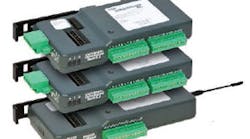COMMUNICATIONS SYSTEMS often require large numbers of input/ output (I/O) points, especially for industrial applications. To bring more versatility to commercial wireless radios (including their own) and wired serial communications systems, FreeWave Technologies has developed a flexible system of base units and expansion modules that allow as many as 15 I/O expansion modules to be added to an Industrial-Scientific-Medical (ISM) band wireless radio system or even a wired serial communications system. That many modules translates into 188 new I/O points on a wireless radio system and as many as 192 new I/O points in a serial communications system.
The I/O expansion modules (see figure) provide a simple means of expanding the range and capabilities of a wireless or serial communications system. They can be added to the firm's FGRIO industrial 902-to-928-MHz frequency-hopped spread-spectrum (FHSS) radios or to a serial base for connection to wired RS-232, RS-422, and RS-485 serial interfaces. The modules form low-latency bus connections, with access times as fast as 11 ms from the first to the 15th/top/last module in a full stack. Each module offers multiple universal channels that can be configured as a digital input, digital output, analog input, analog output, or for sensor power.
The new base units and expansion modules include the model IOE-4440 serial base and model IOEX-4440 expansion module, with four universal channels, four input-only channels, four isolated digital input channels, and no isolated digital output channels; the model IOE-4422 serial base and model IOEX-4422 expansion module, with four universal channels, four input-only channels, two isolated digital input channels, and two isolated digital output channels; and the model IOE-4404 serial base and model IOEX-4404 expansion module, with four universal channels, four input-only channels, no isolated digital input channels, and four isolated digital output channels.
The modules and their base units are ideal for adding connectivity in industrial communications applications. The modules provide easy sensor selection with native support for sensor current of 4 to 20 mA, voltages from +1 to +5 VDC, and transducer voltages from 0 to +10 VDC with loop power. These are accurate network nodes, tested and tuned to provide better than 0.1% measurement accuracy across an operating temperature range of -40 to +75C. They are also suitable for less-than-ideal operating environments, being UL approved for Class 1, Division 2, Groups A, B, C, and D.
The modules and base units are a good fit for the company's FHSS radios which operate with transmit power levels of 5 mW to 1 W from 902 to 928 MHz with occupied bandwidth of 230 kHz. These radios achieve a line-of-sight (LOS) range to 60 miles across a single hop. These versatile unlicensed-band radios provide 7 user-selectable frequency hopping bands, with 50 to 112 hopping channels and 15 hopping patterns per band, for a total of 105 user-selectable hopping patterns. Communications reliability is provided by 32-b cyclic-redundancy-check (CRC) error detection (retransmitting on a detected error) while link security is ensured by means of dynamic key substitution data encryption. The 900-MHz radios achieve link throughputs to 115.2 kb/s. They operate on voltages of +6 to +30 VDC, with maximum current consumption of 1 A at +6 VDC and 200 mA at +30 VDC during transmit mode.
The modules and base units are expandable to accommodate as many as 16 modules. They are ideal for point-to-multipoint communications systems.JB

